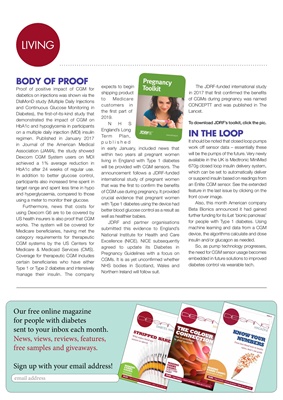
LIVINGLIVING
BODY OF PROOF
Proof of positive impact of CGM for
diabetics on injections was shown via the
DIaMonD study (Multiple Daily Injections
and Continuous Glucose Monitoring in
Diabetes), the first-of-its-kind study that
demonstrated the impact of CGM on
HbA1c and hypoglycemia in participants
on a multiple daily injection (MDI) insulin
regimen. Published in January 2017
in Journal of the American Medical
Association (JAMA), the study showed
Dexcom CGM System users on MDI
achieved a 1% average reduction in
HbA1c after 24 weeks of regular use.
In addition to better glucose control,
participants also increased time spent in
target range and spent less time in hypo
and hyperglycemia, compared to those
using a meter to monitor their glucose.
Furthermore, news that costs for
using Dexcom G6 are to be covered by
US health insurers is also proof that CGM
works. The system will be covered for
Medicare beneficiaries, having met the
category requirements for therapeutic
CGM systems by the US Centers for
Medicare & Medicaid Services (CMS).
Coverage for therapeutic CGM includes
certain beneficiaries who have either
Type 1 or Type 2 diabetes and intensively
manage their insulin. The company
expects to begin
shipping product
to Medicare
customers in the
first part of 2019.
NHS England's
Long Term Plan,
published in early
January, included
news that within two
years all pregnant
women living in England with Type 1
diabetes will be provided with CGM
sensors. The announcement follows
a JDRF-funded international study of
pregnant women that was the first to
confirm the benefits of CGM use during
pregnancy. It provided crucial evidence
that pregnant women with Type 1
diabetes using the device had better
blood glucose control as a result as well
as healthier babies.
JDRF and partner organisations
submitted this evidence to England's
National Institute for Health and Care
Excellence (NICE). NICE subsequently
agreed to update its Diabetes in
Pregnancy Guidelines with a focus on
CGMs. It is as yet unconfirmed whether
NHS bodies in Scotland, Wales and
Northern Ireland will follow suit.
The JDRF-funded international
study in 2017 that first confirmed the
benefits of CGMs during pregnancy
was named CONCEPTT and was
published in The Lancet.
To download JDRF's toolkit, click the
pic.
IN THE LOOP
It should be noted that closed loop
pumps work off sensor data - essentially
these will be the pumps of the future. Very
newly available in the UK is Medtronic
MiniMed 670g closed loop insulin delivery
system, which can be set to automatically
deliver or suspend insulin based on
readings from an Enlite CGM sesnsor.
See the extended feature in the last issue
by clicking on the front cover image.
Also, this month American company
Beta Bionics announced it had gained
further funding for its iLet 'bionic pancreas'
for people with Type 1 diabetes. Using
machine learning and data from a CGM
device, the algorithms calculate and dose
insulin and/or glucagon as needed.
So, as pump technology progresses,
the need for CGM sensor usage becomes
embedded in future solutions to improved
diabetes control via wearable tech.
Our free online magazine
for people with diabetes
sent to your inbox each month.
News, views, reviews, features,
free samples and giveaways.
Sign up with your email address!
email address